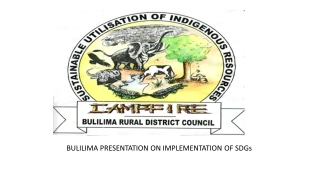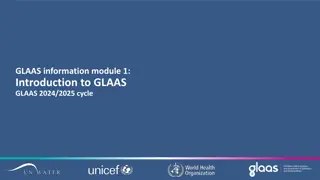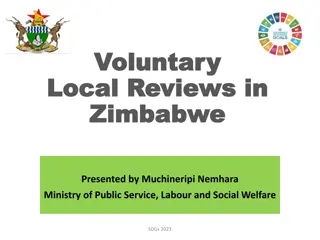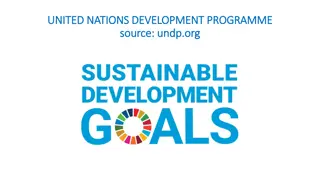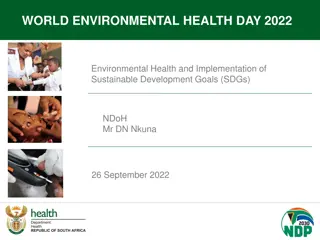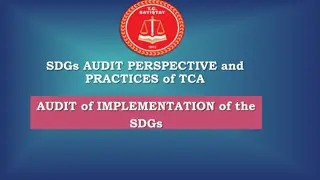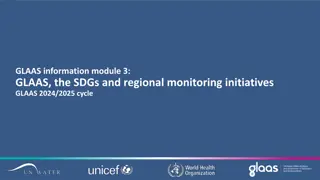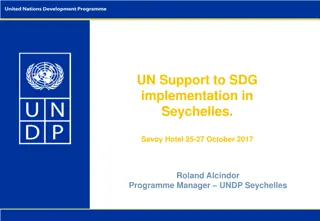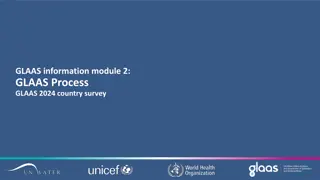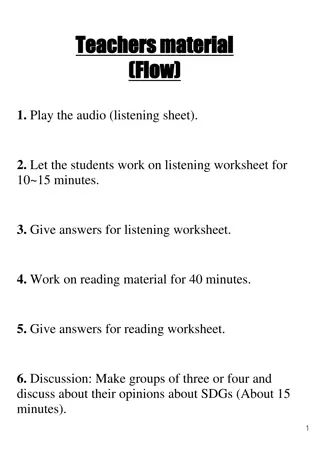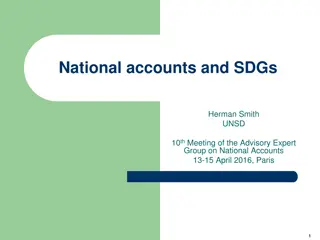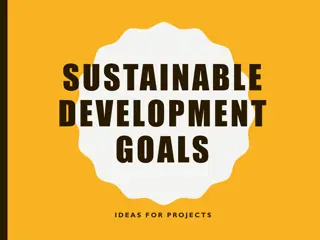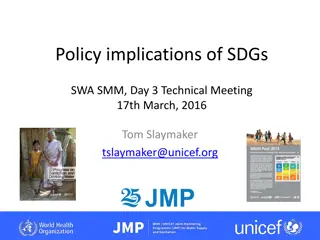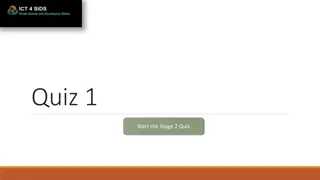Overview of GLAAS and TrackFin in Relation to SDGs & Monitoring Initiatives
GLAAS and TrackFin play crucial roles in aligning with SDGs, particularly focusing on water and sanitation targets. The 2030 Agenda emphasizes the importance of sustainable development through various global indicators and targets, such as access to basic services, universal health coverage, and mitigating deaths from water-related disasters. Additionally, SDG 6 highlights global indicators related to drinking water, sanitation, ecosystems, cooperation, and participation. The monitoring of Goal 6 involves custodian agencies overseeing indicators like safely managed drinking water services, sanitation services, water stress levels, and community participation in water management. JMP's role in SDGs revolves around providing basic services, data from surveys, and addressing inequalities, while also aiming for higher service standards like safely managed water and sanitation. The ultimate target is achieving universal access to safe drinking water by 2030.
Download Presentation

Please find below an Image/Link to download the presentation.
The content on the website is provided AS IS for your information and personal use only. It may not be sold, licensed, or shared on other websites without obtaining consent from the author. Download presentation by click this link. If you encounter any issues during the download, it is possible that the publisher has removed the file from their server.
E N D
Presentation Transcript
Overview of how GLAAS and TrackFin fit into the SDGs and other monitoring initiatives Module 3 GLAAS 2018/2019 cycle
The 2030 Agenda for Sustainable Development: 17 goals, 169 targets, 232 global indicators 2
Eight Water and Sanitation Targets Entire Goal 8 Targets 11 indicators 3
Seven others with direct links to WASH 1.4 Access to basic services 3.8 UHC Tracer Interventions 3.9 Deaths from water pollution 4.a Basic WASH facilities in schools Entire Goal 8 Targets 11 indicators 11.1 Safe and affordable housing and basic services 11.5 Reduce deaths from water-related disasters 13.2 Climate- resilient planning 4
SDG 6 global indicators and targets 6.1.1 JMP 6.1 Drinking water 6.2 6.6.1 6.6 Eco- systems UN-Water Sanitation and hygiene 6.2.1a 6.2.1b 6.a and 6.b Cooperation and participation 6.a.1 6.b.1 6.3 6.5 Waste- water and water quality Water manage- ment 6.5.2 6.3.1 6.4 Water use and scarcity 6.3.2 6.5.1 GEMI GLAAS 6.4.2 6.4.1 5
11 global indicators for monitoring Goal 6 Indicator Custodian agencies Indicator (brief title) 6.1.1 WHO/UNICEF Safely managed drinking-water services 6.2.1a 6.2.1b Safely managed sanitation services Handwashing materials WHO/UNICEF 6.3.1 WHO, Habitat Safely treated wastewater 6.3.2 UNEP Ambient water quality in water bodies 6.4.1 FAO Level of water stress 6.4.2 FAO Change in water use-efficiency over time 6.5.1 UNEP Degree of integrated water resource management implementation 6.5.2 UNECE, UNEP Transboundary basin areas with operational arrangements for cooperation 6.6.1 UNEP Change in wetlands extent over time 6.a OECD, WHO Water and sanitation ODA as part of coordinated spending plans 6.b WHO Participation of local communities in water and sanitation management
JMP and the SDGs What s the same (mostly)? Basic services (similar to improved facilities) Data from household surveys Focus on inequalities (even more so) What s new? Higher levels of service (safely managed water, sanitation) Hygiene WASH in schools and health care facilities reports coming in 2018
Target 6.1: Drinking-water By 2030, achieve universal and equitable access to safe and affordable drinking water for all 6.1.1: Population using safely managed drinking-water services Definition: Population using an improved drinking water source which is: located on premises, available when needed, and free of faecal and priority chemical contamination Accessibility Availability Quality
Target 6.2: Sanitation and hygiene By 2030, achieve access to adequate and equitable sanitation and hygiene for all, and end open defecation, paying special attention to the needs of women and girls and those in vulnerable situations 6.2.1a: Population using safely managed sanitation services including a handwashing facility with soap and water Definition: Pop. using an improved sanitation facility which is: not shared with other households and where excreta are safely disposed in situ or transported and treated off-site Accessibility Quality
Target 6.2b: Handwashing 6.2.1b Proportion of population with handwashing facilities with soap and water at home
Data sources: GLAAS 2018 survey question D9 on how external funding channeled Expanded to cover IWRM TrackFin If a country participates, data can complement GLAAS survey data OECD Data on Official Development Assistance through Creditor Reporting System from DAC data
Data Sources: GLAAS 2016 Survey question A14 Expanded to cover IWRM Revised question on administrative units and number with participation policies/procedures OECD Potentially through Water Governance Indicators
Aspirational global targets 55. The Sustainable Development Goals and targets are integrated and indivisible, global in nature and universally applicable, taking into account different national realities, capacities and levels of development and respecting national policies and priorities. Targets are defined as aspirational and global, with each Government setting its own national targets guided by the global level of ambition but taking into account national circumstances. Each Government will also decide how these aspirational and global targets should be incorporated into national planning processes, policies and strategies. It is important to recognize the link between sustainable development and other relevant ongoing processes in the economic, social and environmental fields. Source: UNGA 2015, Transforming our World 15
Aspirational targets and link with GLAAS 2018/19 focus on national targets GLAAS survey features questions on national targets and country reported progress towards reaching those targets Results will capture progress that is being made that may not be reflected in global 6.1 and 6.2 reporting
GLAAS and SDG monitoring GLAAS has also expanded the country survey to include topics related to SDG 6 including: Wastewater Integrated water resource management Ambient water quality Regulation Participating in GLAAS complements other SDG 6 monitoring initiatives TrackFin data will also contribute to monitoring 6.a
Collaboration with AMCOW GLAAS continues to work closely with the African Ministers Council on Water (AMCOW). The GLAAS 2018 survey has been mapped onto the N gor indicators and can contribute data, reducing the reporting burden on countries. The GLAAS team has also worked with AMCOW to align indicators from the Africa Water Sector and Sanitation Monitoring and Reporting with GLAAS and TrackFin. AMCOW sanitation and M&E focal points can contribute to the GLAAS process at national level.
Collaboration with other regional initiatives GLAAS findings are presented as evidence for regional conferences such as Latinosan in Latin America and SACOSAN in South Asia. In Europe, GLAAS synergy with the Protocol on Water and Health supports setting baselines and identifying national targets.
Collaboration with SWA GLAAS is the evidence arm of SWA. GLAAS 2019 report will be launched ahead of the High Level Meeting (HLM) in 2020. GLAAS is a data source for monitoring SWA s four Collaborative Behaviours Participating in GLAAS will help with preparatory work for the 2020 HLM.
Collaboration with WASH BATs The two tools are complementary and ultimately serve different purposes. If a country recently conducted a WASH BAT before a GLAAS data collection period, the WASH BAT can feed into the GLAAS survey. If a country participates in GLAAS and wants to dive deeper into certain topics, it could conduct a WASH BAT. GLAAS questions have been mapped onto the next version of the WASH BAT and GLAAS sections align with WASH BAT building blocks. UNICEF and WHO are working together to continue to ensure alignment and cooperation.
Thank you! For additional information or assistance please contact glaas@who.int


